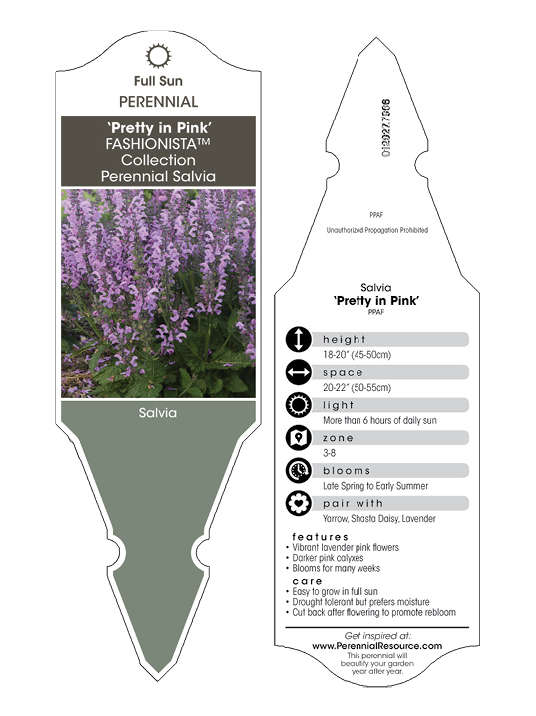Although reading plant tags may seem overwhelming, the information they provide is crucial for successfully selecting plants for your home gardens and containers.
Let’s see if we can ‘unravel the mystery’ of plant tag lingo.
Not all plant tags are created equal. Most tags provide only basic, generic information about the plants they are attached to. Annual flower tags can be tough to read, as their information is often written in a foreign language. This isn’t very helpful! Additionally, due to the small size of many plant tags, there is limited space for plant information.
Reading a plant tag.
There have been vast improvements in the last twenty years on plant tag information. If you’re looking to purchase plants, particularly perennial plants, you can expect to find the following plant information on the tag.

Our example Plant Tag – Salvia ‘Pretty in Pink’
On the front of the tag.
- The common and Latin names of the plant – Latin names are specific to each plant.
- The light required for the best-growing results is usually shown with a sun symbol.
- A picture of the plant’s best features. For this example, the ‘pretty pink flower stocks.’
On the back of the tag.
- The height of the plant at maturity. Remember perennials require about 3-4 years of growth to mature. Annuals mature in one growing season. Shrubs require about 4-5 growing seasons to mature. Trees much longer.
- The space required ‘between each plant‘ at the time of planting to allow for enough room to mature without smothering each other out.
- The best light conditions for optimum growth. The amount of direct sunlight the plant needs to receive each day.
- The growing zone or zones for best growing results. Here in Simcoe County, we are a zone 4-5 depending on your location. Selecting plants that grow in your zone will result in flourishing gardens.
- The approximate time of year to expect flower blooms. Please note, if you’re great at deadheading, some perennials will re-bloom through the growing season like our example, Salvia ‘Pretty in Pink’. A bonus! But you have to deadhead.
- Plants that grow well or ‘pair well’ together in a garden setting.
- Any special features. “Vibrant lavender pink flowers held on darker pin calyxes (that’s the part the holds the flower on the stem) and blooms for weeks with cutting back (deadheading, there it is again!).
- Easy care once established! Let talk about this word ‘established’. In the plant world, established means plants that have been in the ground for at least 2-3 growing seasons, or have overwintered for at least 2 years; you have provided water at least twice per week for the first growing season; and you have watered these plants really well during times of drought. If you haven’t received rain in five or more consecutive days, then it is considered ‘drought conditions’ for a garden. Don’t forget, you can have drought conditions in the Spring and Fall as well. Basically, if we don’t have snow on the ground, you need to be prepared to water.
The plant information you won’t find on the tag; however, you can it online.
- Grows best in loam and sandy soil. Clay soil conditions are not great for this plant.
- Grows to a medium height of 18-20” tall and 18-20” wide at maturity.
- Great for planting on slopes or banks, which means Salvia ‘Pretty in Pink’ develops deep roots .
- Beneficial plant for pollinators with nectar-rich flowers attracting honeybees and native bees.
- The flower shape is perfect for attracting butterflies and hummingbirds.
- Great as cut flowers.
- The foliage of Salvia is aromatic, having its very own unique smell, which is not so appealing to deer and rabbits.
- Can be divided every three to five years in the early spring for additional plants.
- May flop over if grown in heavy, rich soil or excessive shade.
- Blooms profusely with regular watering. So, you need to water if you want lots of blooms.
- Dislikes being located where it is damp over the winter or in standing water.
Salvia is an excellent, easy-to-grow plant for a summer show of intense colour. Salvia performs best in full sun. A real heat lover; it responds well to shearing after it blooms to prompt fresh foliage and blooms.
Here is my suggestion.
Since a plant tag is small, it contains limited information. By conducting online research at home, you can create your customized plant list, which is perfect for a trip to the nursery. Having a shopping list of plants is an effective way to stay focused, especially when there are numerous plant options and attractive colours that can easily lead to distractions.
We all appreciate a good plant tagging.
The information on a plant tag is essential for selecting plants that will grow and thrive in your gardens and containers. Just remember, you need to do your homework. One trick I’ve learned is to take a cell phone picture of any new plant tags I find in the nursery so I can check them out once I’m back in the office.
I hope I’ve been able to take a bit of the mystery out of reading plant tags and their lingo.
Happy Shopping!
Lexi Dearborn
The Gabby Gardener
April 2022
